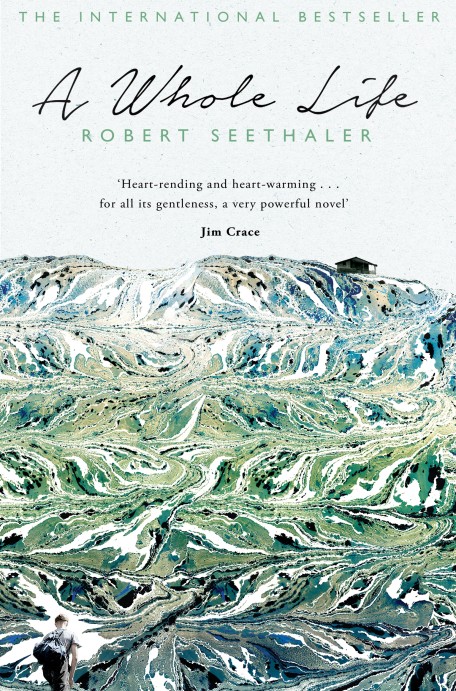You have no items in your cart. Want to get some nice things?
Go shopping
Loudly praising a book which, deep in the very texture of its writing, seems to shirk both loudness and praise is a troubling task. I want to vaunt Robert Seethaler’s A Whole Life. I want to press it aggressively into people’s hands. But this seems a mistreatment: its language, its length and the inclinations of its central character all call for restraint. The following will be a test, then, to see how forcefully I can whisper about this Man Booker International Prize shortlisted novel.
The brevity of the volume seems to contradict the bold promise of its title, A Whole Life (cf. Hanya Yanagihara’s paradoxically named A Little Life, weighing in at 720 pages). But Seethaler’s title doesn’t lie: within its 150 pages this book encompasses an entire life, that of Austrian mountain-dweller Andreas Egger. “As a child,” we learn early on, “Andreas Egger had never shouted or cheered”. This comes to be the refrain of Egger’s existence; his loudest act is his proposal to his wife, designed to “engrave itself for ever on Marie’s memory and heart”. “Ideally,” he decided, he would “inscribe his love on the mountain, in huge letters, visible for miles around to everyone in the valley”, and this is what he goes on to do, “with the devil’s ink, which was to say, with fire”. And yet, even this act – the closest to shouting or cheering that Egger would ever come – is not quite as showy as it might have been: it is largely devised by the friend to whom he turns for help, and, when the moment comes, the “M” of Marie’s name “was rather crooked, and there was a piece missing, too, so that it looked as if someone had pulled it apart in the middle”. Marie responds “so quietly he wasn’t sure he’d understood her correctly”, and “Egger felt as if he was about to keel backwards off the tree stump; but he stayed on his seat” – true to bathetic form.
In an illuminating moment of self-reflection we read that Egger “saw himself as a small but not unimportant cog in a gigantic machine called Progress”. Hints of the progress of wider society are filtered into Egger’s consciousness, but they are peripheral to his concerns and those of the narrative. So, for example, during the Second World War he finds himself in the mountain to “set a series of blast holes” and “secure the forward position” – which sounds like an important task, but he “had no idea what forward position they were referring to or even what such a position might be”. During occasional visits from his comrades he gleans “news from the front (things were seesawing back and forth, there had been losses but also some gains, all in all no one really knew what was going on)”, and it is typical that significant political developments should be relayed parenthetically. Later, “[n]ews of the end of the war reached Egger in one of the communal toilets”; this life-changing pronouncement occurs off-stage, as it were, in the margins of the scene.
Through the filter of the nature-loving Egger Seethaler communicates social and political developments. “[G]eraniums hung outside the windows again instead of swastikas”, and, later, when Eggers returns to the place where he worked, “[l]ittle white flowers now blossomed on the spot where the general manager had sat behind his desk”. This habit of redirection, of guiding our gaze away from large-scale events to seemingly insignificant ones, reminds me of Edward Upward’s praise of E. M. Forster’s writing (recorded in Christopher Isherwood’s Lions and Shadows): “There’s actually less emphasis laid on the big scenes than on the unimportant ones: that’s what’s so utterly terrific,” he wrote. “It’s the completely new accentuation – like a person talking a different language.” This focus on “unimportant” scenes is exactly what Auden describes in “Musée des Beaux Arts”. He knows that “even the dreadful martyrdom must run its course/ Anyhow in a corner, some untidy spot/ Where the dogs go on with their doggy life and the torturer’s horse/ Scratches its innocent behind on a tree.” Seethaler’s redirection of our attention away from the “big scenes” is a striking testament to Auden’s interest in the “corner, some untidy spot”.
It feels fitting to bring in poetry here, for A Whole Life is a deeply poetic book. Vivid images abound, translated with beautiful lyricism by Charlotte Collins. The description of Marie’s hand: ‘”rough and warm like a piece of sunlit wood”. The “peculiar noise” which wakes Egger in the night , “no more than an intimation, a soft whisper stealing around the walls”, and then the “shock wave” of the avalanche, which made the ‘”windows tremble, and everywhere Madonna figurines and crucifixes fell”, and while a “cloud of snow dust… seemed to swallow the stars”. There is so much to enjoy here; my copy is riddled with underscores.
Comparisons have been drawn with John Williams’ Stoner, and there is much in this, I think. These books share an interest in realism, a realism which doesn’t care for twists and turns and Hollywood happy endings, but plucks at your heartstrings with its restraint and its beautifully spare language. Julian Barnes wrote: “The sadness of Stoner is of its own particular kind. It is not, say, the operatic sadness of The Good Soldier, or the grindingly sociological sadness of New Grub Street. It feels a purer, less literary kind, closer to life’s true sadness.” It is this closeness to “life’s true sadness” which makes these books great; there is nothing “operatic” here. Instead, both novels examine the banal without apology, recognising the truth in Auden’s observation that suffering “takes place/ While someone else is eating or opening a window or just walking dully along”.
A Whole Life is published by Picador.

About Xenobe Purvis
Xenobe is a writer and a literary research assistant. Her work has appeared in the Telegraph, City AM, Asian Art Newspaper and So it Goes Magazine, and her first novel is represented by Peters Fraser & Dunlop. She and her sister curate an art and culture website with a Japanese focus: nomikomu.com.




